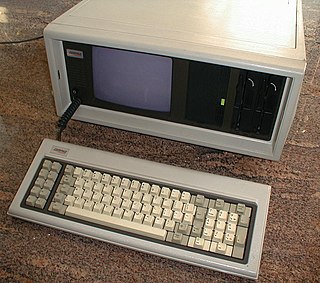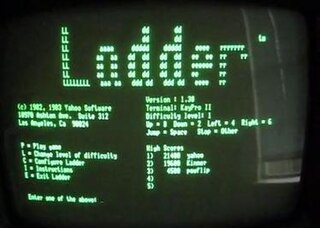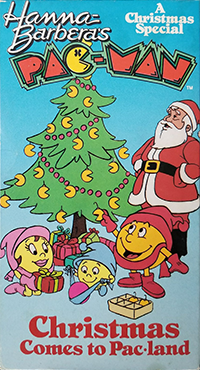
WordStar is a discontinued word processor application for microcomputers. It was published by MicroPro International and originally written for the CP/M-80 operating system, with later editions added for MS-DOS and other 16-bit PC OSes. Rob Barnaby was the sole author of the early versions of the program.

CP/M, originally standing for Control Program/Monitor and later Control Program for Microcomputers, is a mass-market operating system created in 1974 for Intel 8080/85-based microcomputers by Gary Kildall of Digital Research, Inc. CP/M is a disk operating system and its purpose is to organize files on a magnetic storage medium, and to load and run programs stored on a disk. Initially confined to single-tasking on 8-bit processors and no more than 64 kilobytes of memory, later versions of CP/M added multi-user variations and were migrated to 16-bit processors.

IBM PC–compatible refers to a class of computers that are technically similar to the original IBM PC from 1981 of computer giant IBM. Like the original IBM PC, they use the Intel x86 architecture and are capable of using interchangeable commodity hardware, such as expansion cards. Initially such computers were referred to as PC clones, IBM clones or IBM PC clones, but the term "IBM PC compatible" is now a historical description only, since the vast majority of microcomputers today ever since the 1990s are IBM compatible, but also because IBM no longer sell personal computers anyway, having sold its division to Lenovo in 2005. "Wintel" is a similar description that is more commonly used for modern computers.

Pac-Man, originally called Puck Man in Japan, is a 1980 maze video game developed and released by Namco for arcades. In North America, the game was released by Midway Manufacturing as part of its licensing agreement with Namco America. The player controls Pac-Man, who must eat all the dots inside an enclosed maze while avoiding four colored ghosts. Eating large flashing dots called "Power Pellets" causes the ghosts to temporarily turn blue, allowing Pac-Man to eat them for bonus points.

Mojibake is the garbled or gibberish text that is the result of text being decoded using an unintended character encoding. The result is a systematic replacement of symbols with completely unrelated ones, often from a different writing system.
Kaypro Corporation was an American home and personal computer manufacturer based in Solana Beach in the 1980s. The company was founded by Non-Linear Systems (NLS) to compete with the popular Osborne 1 portable microcomputer. Kaypro produced a line of rugged, "luggable" CP/M-based computers sold with an extensive software bundle which supplanted its competitors and quickly became one of the top-selling personal computer lines of the early 1980s.

The Osborne Computer Corporation (OCC) was an American computer company and pioneering maker of portable computers. It was located in the Silicon Valley of the southern San Francisco Bay Area in California. Adam Osborne, the founder of the company, developed, with design work from Lee Felsenstein, the world's first mass-produced portable computer in 1981.

The Osborne 1 is the first commercially successful portable computer, released on April 3, 1981 by Osborne Computer Corporation. It weighs 24.5 lb (11.1 kg), cost US$1,795, and runs the CP/M 2.2 operating system. It is powered from a wall socket, as it has no on-board battery, but it is still classed as a portable device since it can be hand-carried when the keyboard is closed.

Ms. Pac-Man is a 1982 maze arcade video game developed by General Computer Corporation and published by Midway. It is a spin-off sequel to Pac-Man (1980) and the first entry in the series to not be made by Namco. Controlling the title character, Pac-Man's wife, the player is tasked with eating all of the pellets in an enclosed maze while avoiding four colored ghosts. Eating the larger "power pellets" lets the player eat the ghosts, who turn blue and flee.

Jr. Pac-Man is an arcade video game developed by General Computer Corporation and released by Bally Midway in 1983. It has the same gameplay as prior entries in the series, but the maze in Jr. Pac-Man scrolls horizontally and has no escape tunnels. The bonus item which moves around the maze changes dots into a form which slows Jr. Pac-Man as they are being eaten.

K.C. Munchkin!, released in Europe as Munchkin, is a maze game for the Magnavox Odyssey 2. Its North American title is an inside reference to then president of Philips Consumer Electronics, Kenneth C. Menkin.

Ladder is a platform game similar to Nintendo's Donkey Kong written for the CP/M operating system and made to be operated on the early Kaypro line of luggable computers. Ladder was written by Yahoo Software of Los Angeles, California. Along with Star Trek, CatChum and Aliens, Ladder was one of the games that came with the software bundle of the early Kaypro computers.
Pac-Man is an American animated television series produced by Hanna-Barbera Productions and based on the Namco video game franchise of the same title. It premiered on ABC and ran for 44 episodes over two seasons from September 25, 1982, to November 5, 1983. It was the first cartoon based on a video game.

Pac-In-Time is a platform game developed by Atreid Concept featuring the arcade character Pac-Man. It was released in 1995 for MS-DOS, Macintosh, Super Nintendo Entertainment System, and Game Boy.

Pac-Man is a fictional character and the titular protagonist of the video game franchise of the same name. Created by Toru Iwatani, he first appeared in the arcade game Pac-Man (1980), and has since appeared in more than 30 licensed sequels and spin-offs for multiple platforms, and spawning mass amounts of merchandise in his image, including two television series and a hit single by Buckner & Garcia. He is the official mascot of Bandai Namco Entertainment. Pac-Man's most common antagonists are the Ghost Gang — Blinky, Pinky, Inky and Clyde that are determined to defeat him to accomplish their goals, which change throughout the series. Pac-Man also has a voracious appetite, being able to consume vast amounts of food in a short timespan, and can eat his enemies by consuming large "Power Pellets".

Following the introduction of the IBM Personal Computer, or IBM PC, many other personal computer architectures became extinct within just a few years. It led to a wave of IBM PC compatible systems being released.

Christmas Comes to Pac-Land is a 1982 American animated Christmas television special of the Saturday morning animated series Pac-Man based on the video game, produced by Hanna-Barbera. It premiered in prime time on ABC on December 16, 1982. The film was ranked #38 in the Nielsen Ratings published the next week.

Aliens is a text-only clone of Space Invaders written for the CP/M operating system and made to be operated on the early Kaypro line of luggable computers. It was written by Yahoo Software of Los Angeles, California. Along with Star Trek, CatChum, and Ladder, Aliens was one of the games that came with the early Kaypro computers.
















